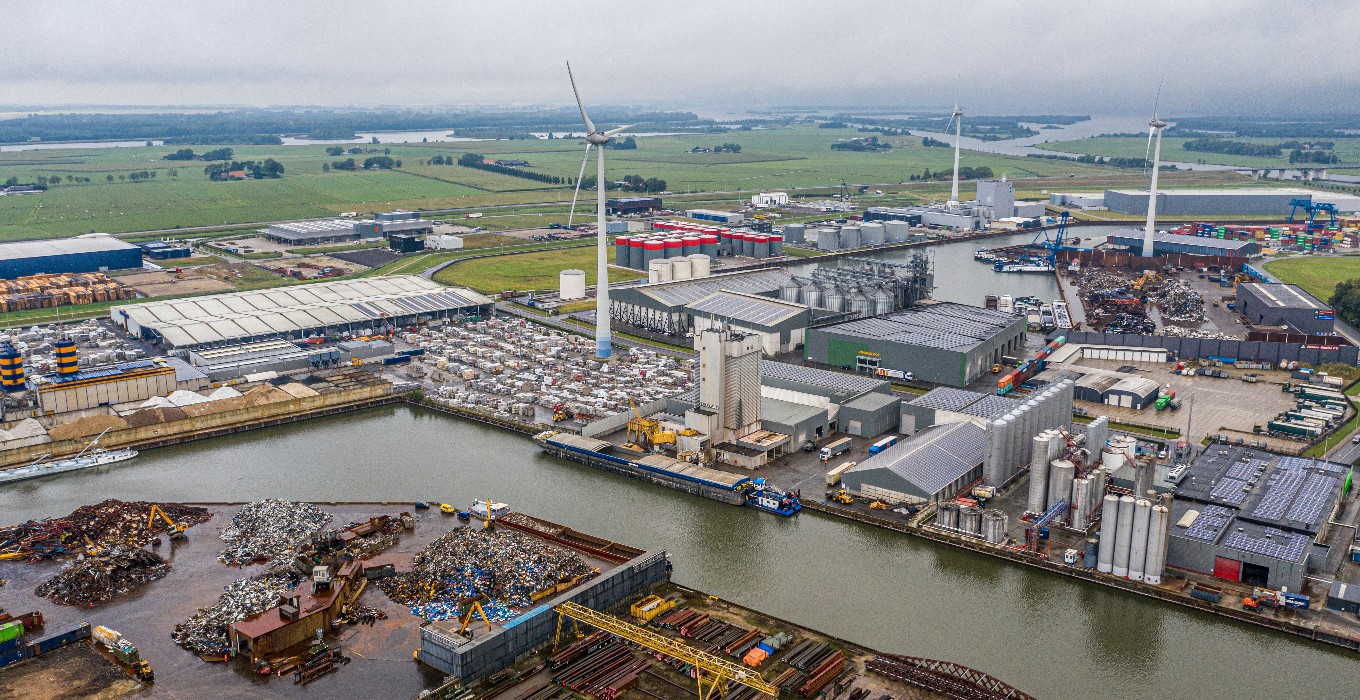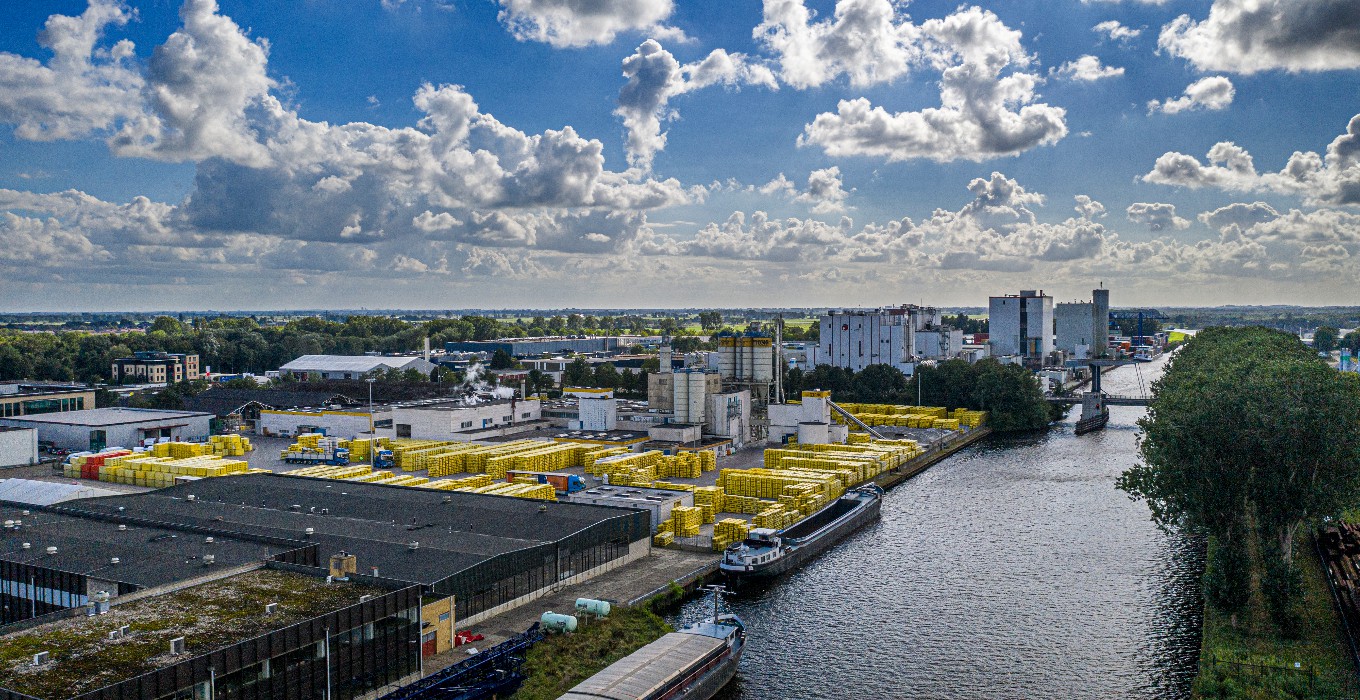
Port of Zwolle: space needed to fulfill role as ‘transition port’
Port of Zwolle aims to grow into the circular engine of Northeast Netherlands in the coming years. With the ports of Zwolle, Kampen, and Meppel serving as the logistical hub and testing ground for sustainable production processes, the cooperative is focusing on the energy transition, biobased construction, and the reuse of raw materials for, among other things, the protein transition. This should make the region not only greener but also economically stronger. However, it does create an additional demand for space. To meet this, the initial focus will be on making better use of (existing) port and industrial areas.
Port of Zwolle consists of three ports—Zwolle, Kampen, and Meppel—that complement each other. Coordination and cooperation are key to accelerating the circular transition and sustainability in the region. Port of Zwolle not only literally functions as a logistical hub but also plays a connecting role as an organization. Additionally, Port of Zwolle must become a landing place for circular production, building on existing activities in the ports and the region.
Port of Zwolle was founded in 2015 by the municipalities of Zwolle, Kampen, and Meppel with the aim of strengthening the economic and social value of the region through a joint port strategy. Port of Zwolle is strategically located and connected to major seaports such as Rotterdam, Amsterdam, and Antwerp, as well as to Northern and Eastern Netherlands and Northeast Europe. The three municipalities explicitly want to position Port of Zwolle as a sustainable and circular port by focusing on circular production processes, the energy transition, and the modal shift.
About 80 percent of transshipment in Port of Zwolle’s harbors consists of building materials, petroleum products, agriculture, and (animal) feed. In addition to transshipment, there is also significant production and processing activity in the ports. Port of Zwolle therefore offers relatively high added value to the regional economy and creates many jobs. But how does a port with strong regional added value also become a driver of the circular economy? The 2022 ambition document “Port of Zwolle – Steering Towards the Future” outlines an initial vision for 2050. It states that by 2050, Port of Zwolle will have various facilities for hydrogen and electric shipping and will be more accessible thanks to investments in the Kornwerderzand locks and improved waterways.
The circular ambitions focus on transition paths such as circular and biobased construction, greening of agriculture, sustainable energy generation and storage, and smart, green logistics. These ambitions build on the existing DNA of the ports.
Data as a driver
Jeroen van den Ende, director of Port of Zwolle, emphasizes that the three ports already host companies whose core business is circular processing, or that handle major flows and therefore already have—or could generate—a significant circular impact. “We have companies that collect waste materials and prepare them for reuse. We also have companies that supply surplus heat back to the grid.” The port authority wants to be the connector between these companies, matching supply and demand.
Van den Ende: “We have collected a lot of data. With this data and research in hand, we approach companies and talk with them about what they can contribute to circular value chains. We also help companies that are less focused on circularity to become ‘more circular.’ We don’t want to exclude companies that find it more difficult. In the Netherlands, we are very good at imposing requirements that drive industries away. But you need existing industries to generate economic value, which in turn can accelerate the circular transition. You shouldn’t throw away old shoes before you have new ones.”
The ambition document itself mentions a “selection at the gate” for new companies, even in times of economic headwinds when new entrants may not be lining up. At the same time, the document points to a “gap” between Port of Zwolle’s ambitious goals and the current state of most businesses. “To bridge this gap, companies must be maximally supported and involved in the transition of Port of Zwolle into a logistical hub for circular industry,” the document states.
Logistics broker
Over the past year, the port authority has already helped several companies move towards more sustainable and circular value chains. For example, Op- en Overslag Meppel BV, specialized in the handling and storage of various road construction products and waste materials, also processes them into new raw materials.
Director and co-owner Jan Mark Oosterhuis explains that waste rubble is crushed into mixed granulate as a new raw material for infrastructure projects. “The waste comes from projects in the region and, after processing, goes back into projects in the same region. Port of Zwolle supports this as a kind of ‘logistics broker.’ Transport usually goes by road, as most sites in the region lack waterways. If there is insufficient local supply, Oosterhuis arranges for bulk shipments by ship from elsewhere.”
Oosterhuis was involved in a pilot to transport residual waste via inland shipping from Limburg to Drenthe, where it is sustainably recycled, and also played a role in lobbying for the widening and deepening of the Kornwerderzand lock complex. This makes Port of Zwolle more attractive for inland and short-sea shipping, benefiting companies in the region. He also highlighted the importance of deepening the Meppelerdiep for Meppel and the region. If the Meppelerdiep is dredged 1.5 meters deeper, heavier ships can once again reach Meppel’s port.
This is crucial, as Port of Zwolle’s strategy envisions Meppel evolving into a raw materials hub and “upcycle hub”—a key facility for processing and high-value reuse of residual flows. Seaports can play an important role when more environmental space is needed. Oosterhuis notes that at Op- en Overslag Meppel BV, three times a week a ship arrives with gravel recovered from tar-containing waste in Rotterdam. The sustainability benefits are clear: one shipload from Rotterdam to Meppel means 80 fewer trucks on the road. From Meppel, the gravel is delivered by road to the concrete plant in Hoogeveen.
Biobased construction materials, battery, protein strategy
Port of Zwolle’s ambitions extend further. Thanks to its optimal water access, the port of Kampen offers opportunities as a location for innovative companies focused on prefabrication and assembly of biobased (construction) materials. The port also serves as a testing ground and pilot plant for new circular and biobased building concepts. Additionally, opportunities exist for raw materials plants at and around wastewater treatment facilities, for example to recover valuable minerals. Port of Zwolle could also become a key hub for the storage and handling of timber from production forests in Scandinavia and Eastern/Central Europe, as well as a location for prefabricated circular housing factories.
The Kampen port area and the Hessenpoort industrial estate in Zwolle, according to Port of Zwolle, both have potential to serve as a “battery” for the region. They are not opposites but complementary. Hessenpoort’s strategic location near a major regional energy hub makes it suitable for large-scale energy infrastructure such as substations, combined renewable generation, hydrogen production, and large-scale battery storage. The Kampen port, by contrast, is particularly suited for sustainable energy generation and storage for green shipping and port logistics, according to the ambition document.
Tapping into the National Protein Strategy, Port of Zwolle also sees opportunities for the production, storage, and processing of plant-based proteins for meat substitutes and cultivated meat, or for producing sustainable proteins from residual streams of grain-handling companies.
Additional space demand
According to estimates by Stec Groep, New Economy, Panteia, and Defacto Urban Development in their report “Sustainable Port Development Port of Zwolle”, new businesses will require an additional 30 to 35 hectares of space by 2040. On top of this, the transition impact for existing businesses will create an additional demand of 40 to 45 hectares. In total, the additional need amounts to 70 to 80 hectares, beyond the current 310 hectares occupied by the ports. However, very little available land remains. The focus is therefore on better use of (existing) port and industrial sites. “By reactivating quays and optimizing logistics, the capacity of existing ports can be expanded,” the ambition document states. A second option is restructuring and physical transformation, which can also help match the right company with the right location. According to Port of Zwolle, restructuring is a complex, lengthy, and costly process. To support this, Port of Zwolle is considering a price surcharge for companies purchasing new or redeveloped land, with the surcharge going into a transformation fund.
In addition to making maximum use of available schemes and funds—such as national or European programs, and provincial schemes for investments in future-proof industrial areas in Overijssel and Drenthe—Port of Zwolle also wants to promote modular and demountable design of plots, buildings, public spaces, and infrastructure, according to the ambition document. Although not mentioned in the document, Van den Ende says the Port of Zwolle cooperative members are also studying the possibility of leasehold land allocation, to gain more control over future use. For now, the municipalities remain the issuing authorities.
Date:
August 15, 2025
Autor:
Translated bij AI
Photographer:


Share with: